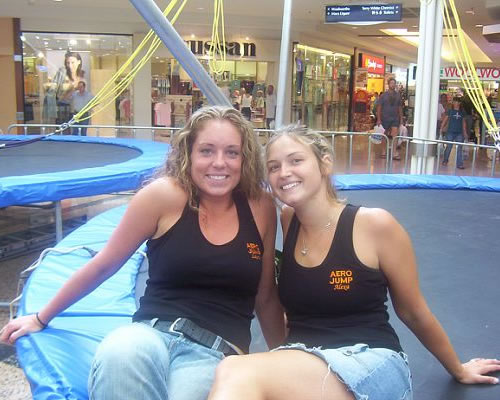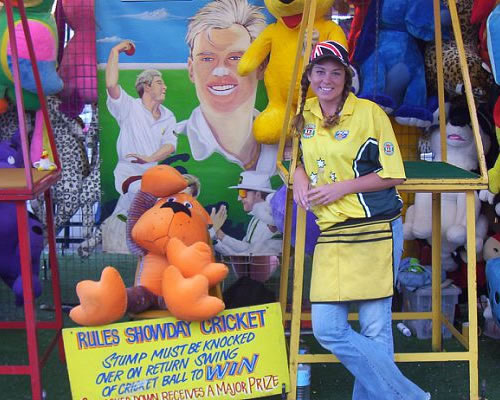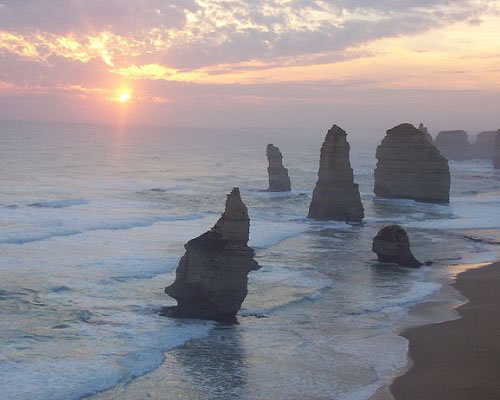Working Holiday in Australia via BUNAC
Adventures Abroad Flying by the Seat of Your Pants
Story and photos by Lauren
Fitzpatrick
9/8/2008 with resources updated 10/4/2023 by Transitions Abroad

|
|
At a job working with trampolines in Australia.
|
Pre-Departure Logistics
knew that my next destination was Australia. I had gone through BUNAC to work abroad before and had no hesitation about doing so again; it would mean a lot of independent planning, and I had to organize my job and accommodation — but that was part of the adventure. Editor's note: BUNAC does provide more and more personal services with each passing year and a database to find and get jobs.
The visa, with processing, currently costs AUD$539 (US$350) through what is called the BUNAC Kickstart Australia package. The visa allows for up to
12 months of work for those aged 18-30 — 18-35 for citizens of a few other partner countries — in the Working Holiday Australia program.
BUNAC requires that you procure insurance before arriving in Australia. You may take out a policy via BUNAC's insurance partnerships, or you may opt to purchase your own if you choose through other insurance company
options depending on your country of origin. World Nomads, for example, handles many insurance requirements and provides support to customize your needs with personalized service in addition to their online quotes. Either way, BUNAC requires that you demonstrate that you have insurance coverage for your entire stay.
BUNAC also offers additional packages, at additional costs described on their site, which provide guided tours and sightseeing on arrival, housing in a hostel in Australia for 4-8 days, access to their national jobs database, 1-to-1 help finding a job with CV assistance, and more.
The minimum wage in Australia is now AUD$23, so that helps offset the high cost of living, whose details are provided by Numbeo for Australia via crowdsourced data so you can get the idea.
The BUNAC program recommended bringing around AUD$5000 (US$3250) as support funds — not that you will likely end up spending anything near that to get set up before finding work. I planned this trip with Alexa, one of my roommates from college. We boarded our Air Pacific flight in November, timing our arrival to coincide with the Australian summer.
Flights to Australia commonly offer free stopovers in one of the Pacific Islands, so take advantage of this. Our flight stopped in Fiji, so we stayed in the Yasawa Islands for several days before moving to Sydney. This meant spending a little extra money before starting the job hunt, but it was an incredible and worthwhile experience.
Arrival in Australia
The trip started with a mandatory orientation in the BUNAC offices. For the first half an hour, we learned all about the dangers of Australia — the sharks, spiders, hoop snakes, and drop bears that make it a dangerous place to visit. Then we were told, "No worries," and assured everything would be fine. Fortunately, that was to be the case.
At that introductory meeting, Alexa and I received all the details regarding what we needed to begin working on — a tax file number (similar concept to the Social Security Number), bank account, and advice on jobs and accommodations. We arranged to have our tax file numbers sent to the BUNAC offices, as we did not have permanent accommodations lined up yet.
We took a few days to figure out the plan. Stay in Sydney? Head up the East Coast? Fly across to Perth? Australia is a vast country, and we wanted to expand ourselves beyond the big cities. After a week on Sydney's Manly Beach, we decided that we wanted to try something new, and the BUNAC office suggested a small coastal town between Sydney and Brisbane that had some strawberry picking work. The next day, we were on a Greyhound bus bound for Coffs Harbour.
Work to Live, Not the Other Way
Around
I came to Australia thinking I would find something casual, but my actual experience was unexpected. I left Australia with several new jobs to add to my resume: fruit picker, bartender, hostel cleaner/receptionist, bungee trampoline operator, and carny (carnival worker). I learned that on the Australian backpacker trail, it is best to avoid planning because you never know what might come up next. Be brave and ask for opportunities; be open and do not turn them down.

|
|
Carnival work in Australia.
|
II did a few bar trials before leaving Sydney, but most pubs in Australia require an RSA — Responsible Service of Alcohol certificate. It is a 1-day course that costs AUD$110, and I was not prepared to spend that kind of money then. Instead, I started working by fruit picking — backbreaking work, but it requires no experience or qualifications.
The strawberry season wrapped up about two weeks after we got to Coffs, but the hostel manager offered us each a job in exchange for free accommodation. I got up every morning at six a.m. to clean the kitchen, while Alexa had to be up by nine to clean the rooms. The hostel quickly became like home; it was small and friendly, and people tended to stay for weeks, so we all became like a little transient family. I got my PADI open water certification and overcame my fear of sharks.
Then, the Coffs Christmas Carnival entered town, and I went down to see if any jobs were available. The next thing I knew, I ran the Looney Hoops stand nightly; half of the carnival staff seemed to be from Aussitel backpackers.
Not long after that, bungee trampolines were set up in the local shopping center, and the operator contacted Aussitel, who passed on the news to backpackers. I was cleaning the kitchen in the morning (free accommodation), bouncing on a trampoline during the day ($10/hour), and working a carnival stall by night ($10/hour). After about five weeks of this, I had saved up enough money to make my way to Cairns on the northeast coast.
A Trip in Australia
Alexa and I bought a 3000km (1800 mile) Greyhound bus pass, which cost AUD$400 and covered our travel from Sydney to Cairns. We stopped at the Federal Backpackers in Bundaberg for a week to top up our funds with more impromptu fruit picking. The hostel took our details (including tax file number — you must have a valid work visa) and arranged jobs for us to start the next day. After a sweaty week of potatoes, chilies, and aloe vera, we continued north to see Fraser Island and sail the Whitsundays.
Once we reached Cairns, I was out of money but not out of contacts — a friend from Coffs knew of work at the Sydney Royal Easter Show. First, I had to take care of legalities; my four months of work were up, but I was not ready to go home. I made an appointment at the immigration office in Sydney and lodged my application for a tourist visa. A few hours, paperwork, and AUD$215 later, I had a sticker on my passport, allowing me to remain in Oz until the end of May. For three weeks, I lived in the back of a moving truck with four other backpackers and worked cash-in-hand at the carnival. It certainly was not easy and was not always fun, but it was something I will never forget.
I joined a group of friends from Aussitel who had bought a car from some other backpackers, and we drove toward Sydney. From there, we drove to Adelaide along the Great Ocean Road. From Adelaide, Alexa flew home, and I flew to Perth on a budget flight. Then, I flew back to Coffs to say goodbye before returning to the States.

|
|
The 12 Apostles along Great Ocean
Road.
|
An Unexpected Twist
Three days before my scheduled flight home, I learned that the receptionist at Aussitel was taking a 3-month holiday. The manager offered me the job. I spent one day deliberating, one day driving to Brisbane for another tourist visa, and one-day calling friends and family to say I would be home in August.
I earned $12 an hour at the time and had my own room behind the reception desk, complete with a small kitchen. It was a great way to meet people, and I could do many of the advertised activities for free: diving, horseback riding, and surf lessons. The best perk was working down the road from the Foreshores Café: if you make it to Coffs, do not leave without getting a banana smoothie from this place! Deciding to work under the table can be a risky move; it worked out for me, but I would advise you to weigh your options before making such a decision.
There are jobs to be found all over Australia; all you have to do is ask. It was nice to have BUNAC's support initially, but as I got more comfortable, I found that I did not need it anymore. I usually opt for stability in my jobs, but in Australia, it proved to be a great way of seeing the country. If you are up for a challenge, skip the conventional office jobs, get to Australia, and see what you can find. Even if you go home broke, it will pay off in the end.
Lauren Fitzpatrick is
an Indiana University graduate who completed
her MA in Travel Writing at Kingston University in London.
See her website LateralMovements for more of her adventures.
|
